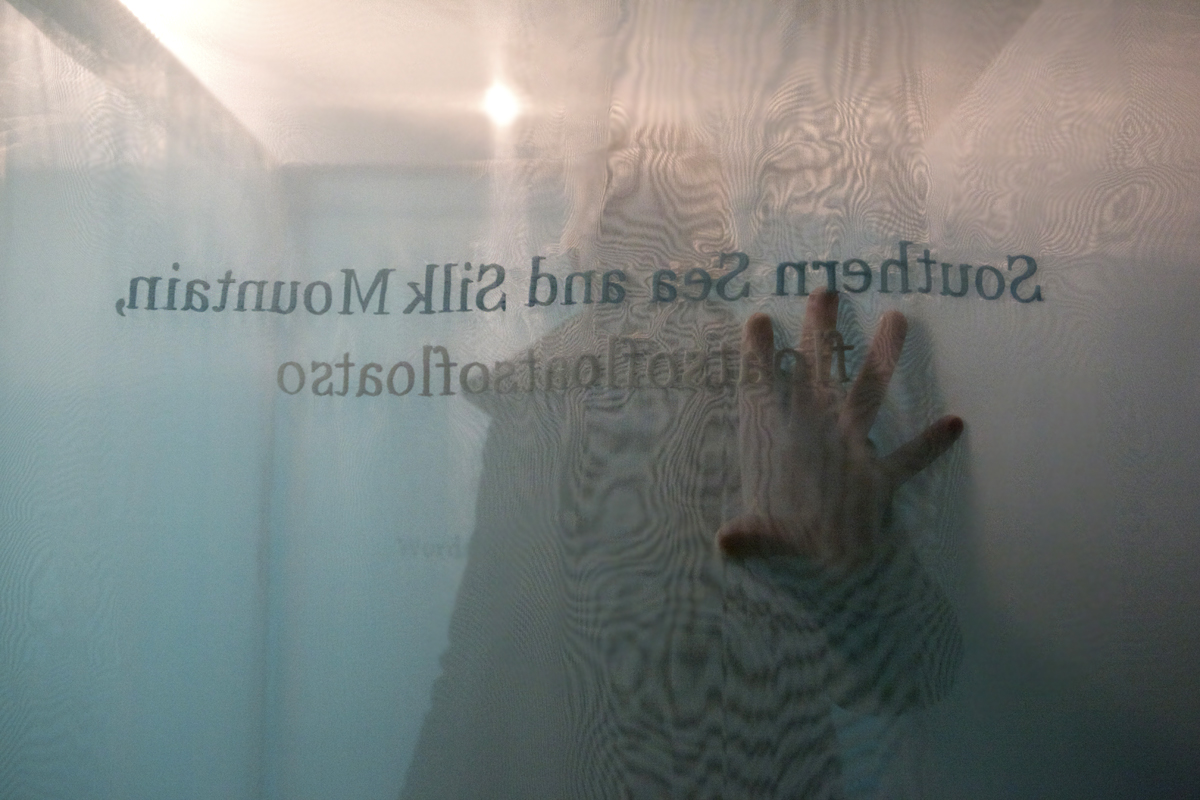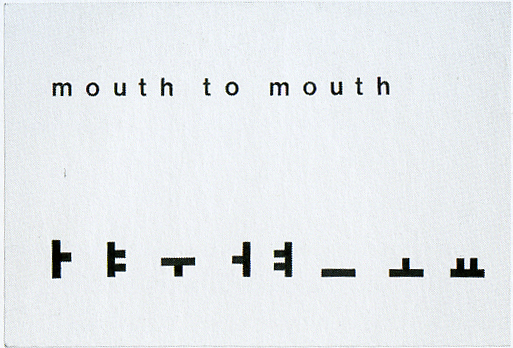Taey Iohe
Dear Imaginary Audience
I am in front of the brick walled gallery. It has been sometime now since I have been here, Seoul. I paused and hesitated as I thought the mirror reflecting me back to the reality. Mirror door seems like hiding something what is behind. I pushed the heavy door to open it, then I encounter four another doors in emerald blue color. This time, I let my arms to open them without any hesitation.
The wave of white silk and blue silk blowing in and out as I moved in between thresholds. Twelve personal space, embroiled letters and diagrams on the translucent scenery. Your wrote something for me, and you put my words at one of the room too. You left me a message; ‘the place you get absolute hospitality. the place you have something to take care, the place you always have to come out to live, you are in the transit and move one place to another without knowing where to go. You are very careful when you step forward across thresholds, because you fell before. hesitating step..’

Threshold Sea, Installation partial view
Now I came out from your Threshold Sea and face stairs. The stairs to go down beams out warm light, the stairs to go up has a cool blue light. I followed warm light to downstairs, I touched cold cement wall in the corridor. I can see three moving images on the each corner in the room, two tilted desks with a red threads, wooden large lightbox installations in the middle. The tilted desks look like it is made for mobile purpose so that it can be fold. I look at them all closely and move the space around like a careful cat.
In two moving images, I can see two actors express something in the sign language and face expressions, it is difficult to judge their gender. The person who wearing the white shirt, she asks me whether something is possible; such as “is it possible to write a letter? is it possible to read this? is it possible to tell me a story? is it possible to translate a foreign language?’ The white signer gestures that her one hand make the clapping sound with her mouth very quickly, and make the sound ‘Pa!’ Soon I could see that it is easy to follow what she try to ask without sub title. The signing was accessible and fun to understand for me.
The other moving image which the signer wearing the black shirt, you unkindly did not put the subtitle. He shows us various expression, he cries, he surprises, he sulks, and he lets go... In the beggining of the video, it says the signer translate the poem, ‘남해금산 (Southern Sea Silk Mountain) by Sung Bok Lee. I saw the full script of poem at the one of drawings in the lightbox in the middle of the room. The poem positioned in the lightbox that it can be read with a same position that I can watch the video it tells the same.
I confront of the drawings, dialogues that you made, photography, and blue print of the installation in the lightbox. I found a piece of my writing, you came to my hometown to search this. You explored page by page, video by video at the archive of my artworks. I now can see that you drew my hand-writing for embroidery. There are interesting strata of the dialogue that you and another Asian American artist made, inspired by the archive of my work.
In the tilted desk, you made knots of red threads from one nail to another nail. I have seen this threads from your previous work (The Lure of the Lawn) too. Removed words between these knots stuck here and there to the garden forks which put standing under the moving images. I think of you removing words and translating words over these traces.
You can only find out the words are not translatable over the undying labour of trying to translate a word.
Isn’t that the deed of writing unyielding doing? as if you tailor the suit with pieces of unfinished thought, unsure decision, loose observations, and vague memory. The suit will be formed as one contained piece. You may write and erase repeatedly, like you saw them and take them apart over again to make the best fitted one.
I came out from the downstairs gallery and walk through upstairs to meet the origin of this cool blue light. I started to hear the layers of voices. It becomes louder as I approach to the space. I met the massive wind pipe that coming in from the corner window. This big pipe coming from outside of the building, puncture the window, and go through and embrace all the walls, ceilings, floors at upstair gallery. The space looked like a inside of someone’s body, the pipes looked like connecting to that body. Some hidden spaces, there were several indistinct texts with a light installations. I read a short dialogue between hammer and hole, the list of things that you are fear of, folded papers, drawings that almost unrecognisable on the ceiling. The layered sounds are sometimes in English, sometimes in Korean. I couldn’t understand in full, but understand the breaks of words; tran-tran-translation, di-di-dias-pora, nam-hae-gum-san etc. You made a soundscapes with a stuttering, repetitions, and imitations of other languages.
In your written introduction, you said ‘Namhaegumsan is a signifier for charged internal memories, not just the geographical material reality of a vast mountain. To speak aloud, how does pronunciation affect this idea? When we pronounce ‘Nam-hae-gum-san’, the lips meet each other, then slip apart, and meet each other again, then drift apart to allow the final syllable. There are spaces and gaps within words, that other meanings might find room for themselves.’. I feel the breathes between those ‘the time apart of lips’ in the space. I put my fingers to comb through the dark walls with a careful step. There are a number of felt beads. They are like a nipples on the body of space, they are on the spot where previous artists in this space puncture through the walls. The holes in this space is the internal space of the body and also the history of this space. And you put the black wellington boots filled the green grlitters under these felt. I imagined this might be my boots.
I think of you taking this exhibition apart. You will pluck the felt beads from the wall, you will dismantle the screens and projectors. You will destroy twelve blue and white rooms, you undrill the nails from ceiling to take all pipe away, unscrew all electric lines that you try to hide from audience. This might be the defining moment of all for making your art. Undoing something reminds us of doing.
We are vaguely connected like cleft lip and cleft palate. The tongue that stretched out from the muscle in the neck dance up and down to find the right moment of finding the right sound, your acts of translating will vibrate the air and come to talk to me.
I pushed the heavy mirror door again to leave this space. I am, again, far away from you.
Your imaginary audience,
Theresa Hak Kyung Cha

A phantom of Theresa Hak Kyung Cha, my imaginary audience, travels through the exhibition that I created and writes to me.
The artist’s eyes become a camera angle, a situated subject, mediating the past of the exhibition and the present reading. The narrator of the letter is doubly displaced – as an imaginary audience and again as a writer of the exhibition. Cha’s eyes show us the exhibition, as if we see through her; with her eyes and as if she is spectral.
Letters and diagrams in English and Korean scripts played out as a non-linear story for an imaginary audience who were invited to explore hospitality and safety in a foreign space.
Language was both liquefied and incorporeal, though had to be brushed aside and passed through to progress through the story. The relationship between the artist, her forebears and imagined audience was dramatised in a self-contained reality-space within the exhibition.
- from artist’s note